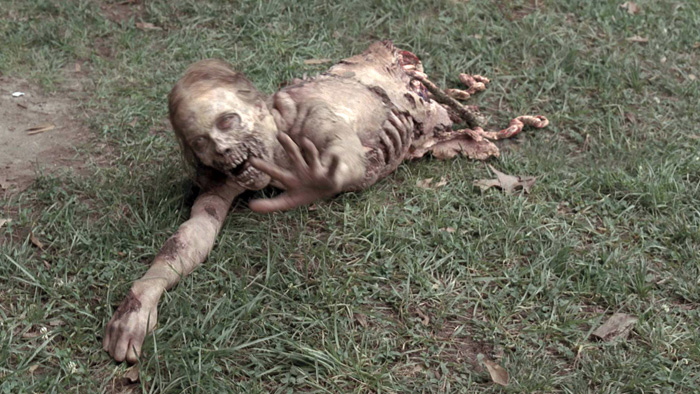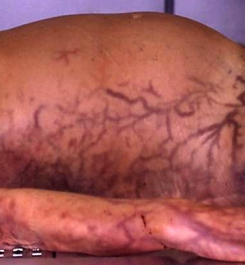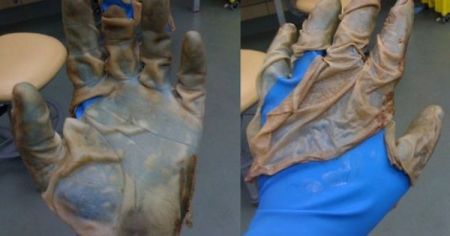So, since this is a death-and-related-things focused blog, I figured that I might as well delve into a pretty fundamental aspect of the whole death thing and write about what happens to something that was alive after it dies. Of course, decomposition isn’t the only thing that can happen to an organism after it dies (I have a whole series of posts about mummies planned, for example), but as a general rule, when something dies it almost immediately begins to decay. If you think of the body as just a really complex collection of proteins, carbohydrates, fats, and minerals, then decomposition is the just the process by which this collection of stuff gets broken down into simpler, separate parts.
Although I’m a person who hangs out with and pokes around in dead people on a regular basis, I try to remain mindful of the fact that not everyone is so comfortable with seeing that sort of thing (I try not to talk about it at the dinner table, you know?). Therefore, in the interests of the squeamish, let me provide this quick warning before we get started: this post features some pretty gnarly images illustrating varying stages of decomposition in dead human bodies. So, if you’re not into the visuals, you might want to block the images on this page until you’re done. I mean, I assume if you’re interested in reading about it, you’ll probably be okay with looking at pictures, but some people think they want to be surgeons and then pass out the first time they see another person’s blood SO YOU NEVER KNOW.
Anyway, moving on, let’s talk about decomposition (yaay!). Obviously, decomposition usually occurs after death — gangrene and necrotizing faciitis being two notable and horrifying examples of this process occurring in living entities, and which you most definitely should not Google if you’ve eaten within the last week. There are two major categories of changes that occur during decomposition: physical and chemical. As well, there are five ‘cardinal’ signs of decomposition that are commonly seen, and denote the early to middle stages: discolouration, gas/swelling, odour, purge, and skin slip. After these stages pass then you’re deep into the decomposition process and you get putrefaction (the people-soup stage) and skeletonization. I might talk about these later stages in another post sometime, but for now we’ll focus on the five cardinal signs, mostly because I’m more familiar with those.

Physical vs. Chemical Changes
The physical changes that occur during decomposition are caused by systems or components within the body reacting to external forces, like gravity. For example, in light-skinned people, pallor (extreme paleness) will occur because, in the absence of a functioning circulatory system, gravity causes the blood too pool in areas of the body closest to the floor. This pooling also causes a corresponding discolouration known as livor mortis, which makes the skin appear purple or red where the blood is collecting in the vessels. So a person laying on their back may be extremely pale in the face, while the back of the neck and the ears appear very red. After a few hours, the blood itself starts to break down and escape the vessels, staining the tissues, at which point it becomes known as post-mortem stain, which is a chemical change, meaning that it is either caused by a chemical reaction or involves the byproducts of one. In this case, the chemical reaction is the breakdown of blood into various different products, which then escape the vessels and enter the nearby tissues. One of these products is heme, which gives blood its red colour, and which stains the tissues when it leaks out of the vessels.

Rigor mortis is also an example of a chemical change that occurs as a very early stage of the decomposition process. In rigor mortis, the muscle fibers become extremely rigid, which results in the body becoming very stiff, with the muscles fixed into position. In life, we sometimes get muscle stiffness and soreness after sustained physical activity due to a build-up of lactic acid as the cells produce ATP (which is a source of energy made from glycogen). When we die and our cells start to expire en masse, it causes a build up of lactic acid in the muscle tissues that the body can no longer clear as its metabolism is no longer functioning. Essentially, rigor mortis is like a full-body charley horse. Rigor usually passes within 24-36 hours as the cells break down even further, though it can pass in as little as 12 hours, or persist for as long as 48 depending on other factors like temperature and cause of death. It can also be released manually by manipulating the limbs, and despite what you may see on TV, it’s actually not that difficult to do, and it definitely doesn’t require the breaking of any bones (I’m looking at you, Santa Clarita Diet).

The 5 Cardinal Signs of Decomposition
As far as I know, the five cardinal signs don’t really occur in a specific order. In fact, there is a fair amount of overlap between them because many of them are interrelated – the same bacteria that cause discolouration also cause gas and odour, for example, and gas can cause purge. All bodies and their contexts and surroundings are different, and these factors can also have significant impacts on the decomposition process. It’s not just the obvious things like temperature and moisture that affect the process either, things like age, fat level, illness, and drug use can cause changes inside the body that also impact how quickly or slowly it decomposes, and how the process unfolds, but I think that’s another post for another day.
Discolouration is pretty reliably among the first of the cardinal signs to occur. We’ve already talked about livor mortis as a form of discolouration, but when talking about the cardinal signs, the discolouration in question occurs specifically in the lower right quadrant of the abdomen, and is green, rather than red. The site of the discolouration is significant, because this where the cecum is located. The cecum is a pouch in the colon where the large intestine empties into the small intestine, and it contains a large amount of bacteria. The presence of this discolouration indicates that this bacteria, which is a normal part of the digestive system during life, has started to proliferate and that waste products are building up in there as they multiply and eat up all of the available nutrients. As this process continues, you may see the green discolouration spread up and across the abdomen, as the bacteria continues to grow and move to new areas of the colon as it seeks out food, expels waste, and dies.
One of the waste products produced by the intestinal bacteria as it digests the abdominal organs is gas. The gases produced by the bacteria cause the abdomen to swell, and, eventually, it may burst open. Gas can also cause dead bodies to appear to burp (or fart), because when there’s a lot of gas and you move the body, it will escape through the most convenient exit, which is usually the mouth (but sometimes the other end). As I mentioned, gas and odour are related — the gases themselves are formed from sulfuric compounds (think rotten eggs), and the smells the produce range from pretty bad to vomit-inducingly bad. Most of the smells of decomposition are caused by the gases produced by bacteria as they break down the body tissues, and they are all super nasty.

Besides odour, gas is also related to purge as well. ‘Purge’ is the term for when liquid products of decomposition are expelled from the body. These liquids can be composed of a number of things, but typically contain blood and what is, essentially, liquified organ tissue from inside the body cavities. Movement of the body might cause purge to occur, in much the same way it does with release of gas, or, the build-up of pressure caused by the gas itself can force the liquid out. Again, it is usually expelled through the mouth, as this is typically the path of least resistance, but it can also come out of the nose, and the anus, and yes, that is as gross as it sounds.
Finally, we have the last cardinal sign, skin slip. Skin slip doesn’t usually appear until a few days into the decomposition process, and if you see skin slip you’re pretty much guaranteed to see the other four things as well, though it’s not always the case. For example, bodies with edema (i.e. a high water content) or in very humid environments may start to display skin slip really quickly, without showing much discolouration first, or evidence of gas or purge. Most of the early phase of decomposition occurs internally as the soft tissues of the organs break down; skin slip is more like the first phase of the breakdown of the external body tissues (aka the skin), and that’s why it generally seems to occur a little bit later than the other signs.
With skin slip, the proteins that hold the top layers of the skin together begin to break down, causing the top layers of skin to come away from the layers beneath. It appears as blisters and/or wrinkling of the skin, and it literally does ‘slip’ off if you apply too much pressure. Picture a sunburn bad enough to blister and peel, only the layer that peels off is somewhat thicker – in a person with darker skin, peeling off the areas of slippage will leave white patches because all of the layers containing melanin (i.e. the epidermis) come away from the layers below. Sometimes, in forensic investigations, some unlucky investigator will (very carefully…) remove slippping skin from the hands of the deceased and wear it over their own (gloved!) hand in order to obtain fingerprints. So glamorous!

After these signs all appear, decomposition really gets going. The whole body will eventually turn brown or black, it will be colonized by insects (this will actually happen almost immediately if a body is left outside), and the flesh will start to liquefy as the proteins that hold it all together begin to break down. There are also some other interesting things that can occur at this point, or instead of this point, like mummification, and saponification, both of which I’m planning to write about eventually. I’ll stop here for now though, as I think 1800 words about decomposing bodies is PROBABLY enough for one sitting, yikes.


[…] to be honest) on steroids. C. perfringens can cause tissue gas in dead bodies as part of the normal process of decomposition — gas gangrene is basically what happens when the bacteria get an opportunity to throw down […]
LikeLike